Sound of the Great Forest
In September, at the beginning of the rainy season, the Lieng River is still dry. The road from National Highway 24 connecting Quang Ngai with the Central Highlands provinces in Ba Thanh commune to Phan Vinh village (Ba Vinh commune - the former base of the heroic Ba To Guerrilla Team) is covered in the green of the mountains and forests. I met Mrs. Pham Thi Sy (Ba Vinh commune, Ba To district, Quang Ngai province) - a gong artist who is over 82 years old and weak. When we asked about the three gongs, Mrs. Sy quickly told her son, Pham Van Rom, to bring a set of three gongs: Tum gong (also called the father gong), Vong gong (also called the mother gong) and Tuc gong (also called the child gong).
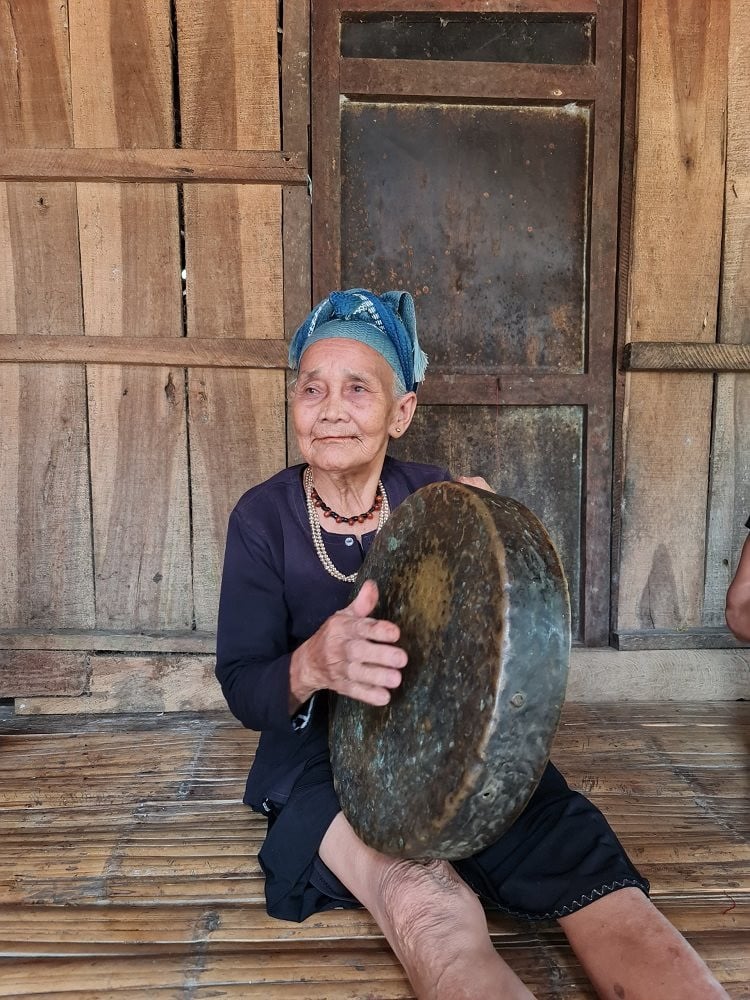
The color of time is condensed on each gong with its smooth black gong rim and its bronze-glittering bull’s-eye. Under the hands marked by time but raised and lowered with determination, the sound of Mrs. Pham Thi Sy’s Vong gong blends with the sound of the Tuc and Tum gongs of Pham Van Rom and his neighbor, Pham Van Nhot. The trio of gongs with three players produces high and low sounds, resonating in the mountains and forests.
The three-piece gong is the most popular and typical musical instrument of the H're people in Ba To district. According to the villagers, it is called the three-piece gong because this set of gongs has three pieces. When performing, the Vong gong is tilted, the Tum gong is placed lying down, and the Tuc gong is hung on a string. The Tum gong plays the role of keeping the rhythm, the Vong gong and the Tuc gong follow the melody. The Vong gong and the Tum gong are played with bare fists, the Tuc gong is played with a fist wrapped in a scarf to keep the gong sound warm. The best gong player will play the Tuc gong, leading the gong ensemble to perform according to the correct piece and rhythm. When performing the three-piece gong ensemble, the gong player sits in a stable position and does not move.
Mrs. Sy remembers clearly, since childhood she knew by heart many ta leu and ca choi melodies of the H're people, every festival, wedding..., along with the sound of gongs and other musical instruments, the villagers sang and danced together. In the dark, the villagers gathered around the flickering fire in front of the stilt house yard, the strong muscular men beat the gongs, the girls sang and danced ta leu and ca choi. The villagers also let their souls follow the sound of gongs. The custom of the H're people is to celebrate Tet by village, by hamlet. Today it could be this village, tomorrow another village. The sound of gongs also resounded throughout the mountains and hills.
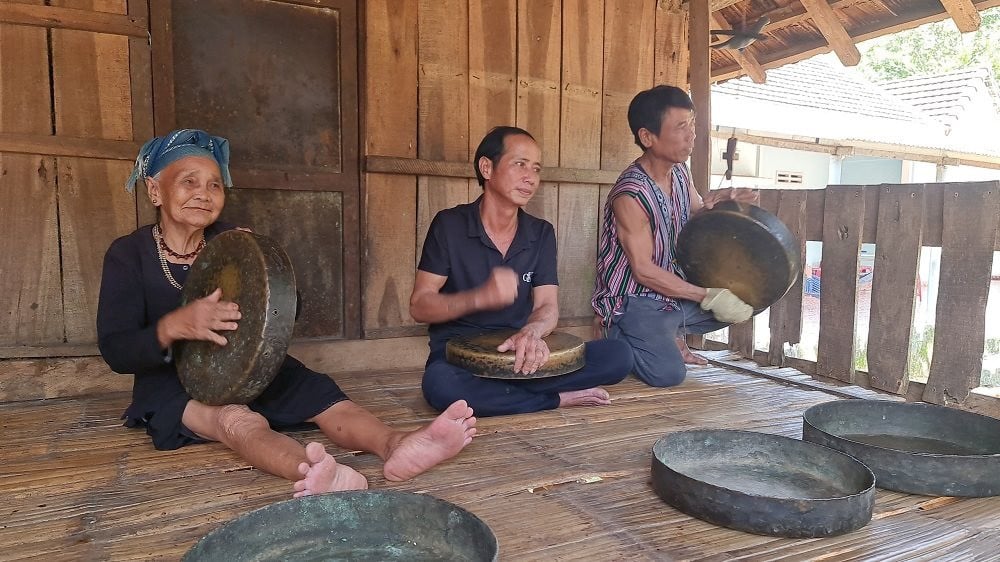
“The gong has been around for a long time, I have seen it since I was born. The gong is unique to the H're people because it is expensive. It can be exchanged for money, silver, buffalo, or cows. The gong is used during Tet, worshiping, festivals, and generally happy occasions. My parents both know how to play gongs. When my father passed away, he left each of his five siblings a set of gongs, boys and girls alike. If a daughter does not play it, she must leave it to her husband or children, and not sell it,” said Mr. Pham Van Rom.
Besides Mrs. Sy, there are some other women in Ba To who also know how to play gongs, such as Mrs. Pham Thi De (Ba Thanh commune). Mrs. Sy said that on moonlit nights when the gongs sounded, she sang ca choi. The lyrics were the heart of a girl, both pure and passionate, to make young men moved and propose their love.
Let the gong ring forever
The H're people in Quang Ngai live mainly in Ba To, Son Ha and Minh Long districts. However, only the H're people in Ba To district know how to perform the gong and it has become a traditional cultural activity. The vast majority of H're gongs are sets of three gongs that are passed down and preserved by families from generation to generation as family treasures. Over hundreds of years, the sound of the gong has become a familiar sound and is closely associated with generations of H're people.
The gongs of the H're people in Ba To have a very unique and wild sound. From the rhythm, tempo to the arrangement of sounds, the harmony, the skillful and delicate use of the gong beaters, there is a beginning, a climax, an end, sometimes solemn, sometimes excited, sometimes throbbing, sometimes strong, urgent, and urging. In the past, rare sets of gongs were worth dozens of buffaloes, the sound was not only clear but also deep, creating a luxurious, strong, and exciting sound.
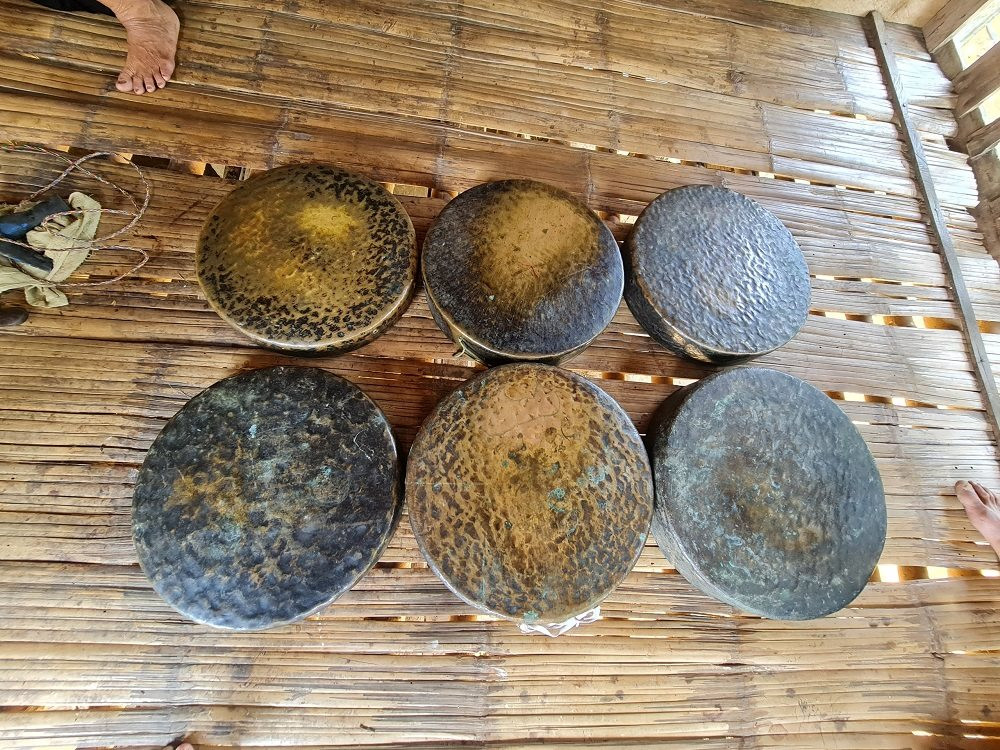
Gong performance is so attractive and captivating to many people, but then, like other cultural forms of ethnic minorities in many places across the country, this activity has faced many challenges due to the integration between highland and lowland cultures.
“Most gong players are men, and the women who know how to play the gong are all older. My mother also knows how to play the gong, but she rarely plays it. Nowadays, very few young people know how to play the gong, like me, I only know a little bit,” said Pham Thi Sung (Ba Thanh commune).
In recent years, the local government has made many efforts to restore and preserve the culture of the H're people, including gong performance. Most communes in Ba To district have maintained the art of gong performance, most notably in Ba Vinh commune.
According to Mr. Le Cao Dinh - Deputy Head of the Department of Culture and Information of Ba To district, the gong performance art of the H're people is not only a cultural activity but more importantly, it preserves traditional cultural and religious values imbued with national cultural identity.
“Every day, they are busy with the fields, farming and many other jobs to make a living, but they are willing to participate when invited to play gongs and attend mass art performances promoting gongs. The enthusiasm of young people warms the hearts of the elderly, because for a long time people have been worried about the decline of traditional arts, including gong playing,” Mr. Dinh shared.
In the past, the H're people only played gongs during Tet or to celebrate the new rice crop. Now, in the program of returning to the source and visiting historical sites in Ba To, tourists can also watch gong performances. In the midst of the vast mountains and forests, the bustling sound of gongs and the sobbing Ta Leu singing (the singing of the H're people) help us understand more about the eternal vitality of the H're people with rich identity. I believe that the art forms of the people, like the Lieng River and the Re River, sometimes ebb and flow, but will flow forever in the hearts of the people.
Currently, in Ba To district, there are about 890 households with gongs, with over 900 sets of Ba gongs and 740 people who know how to use them. In 2021, the art of performing Ba gongs of the H're people in Ba To was recognized by the Ministry of Culture, Sports and Tourism as a national intangible cultural heritage.
Source


![[Photo] Students of Binh Minh Primary School enjoy the full moon festival, receiving the joys of childhood](https://vphoto.vietnam.vn/thumb/1200x675/vietnam/resource/IMAGE/2025/10/3/8cf8abef22fe4471be400a818912cb85)



![[Photo] Prime Minister Pham Minh Chinh chairs meeting to deploy overcoming consequences of storm No. 10](https://vphoto.vietnam.vn/thumb/1200x675/vietnam/resource/IMAGE/2025/10/3/544f420dcc844463898fcbef46247d16)





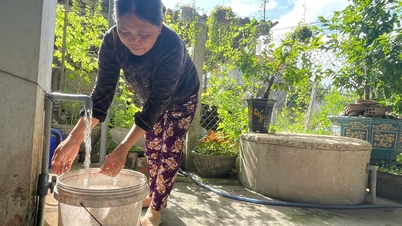










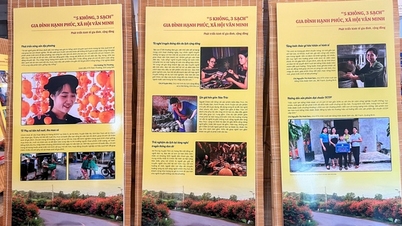

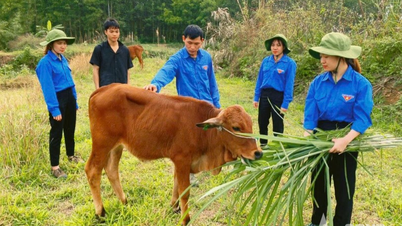

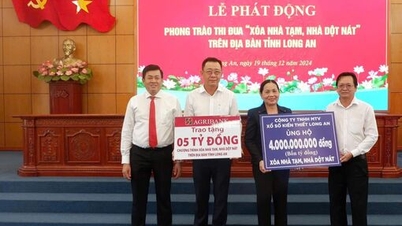








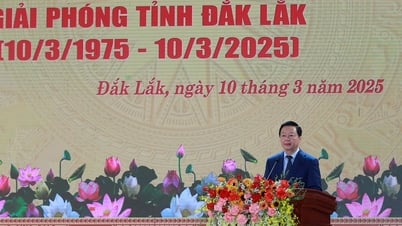

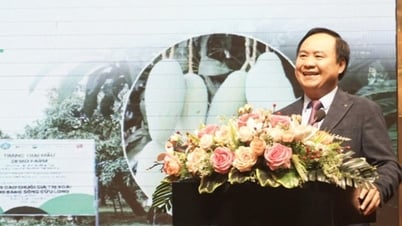















































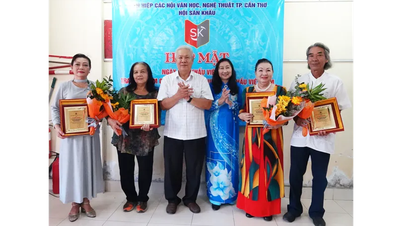






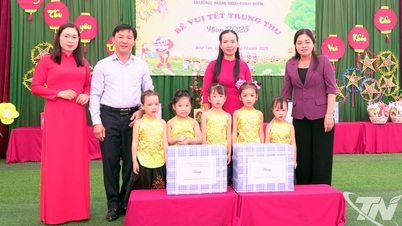














Comment (0)